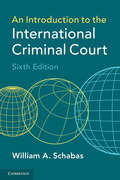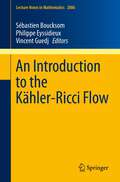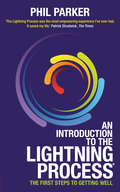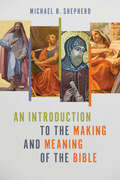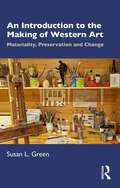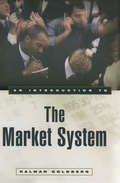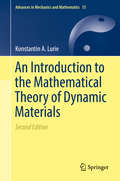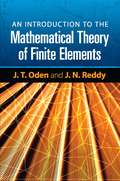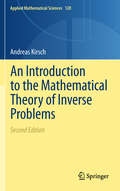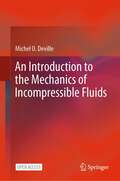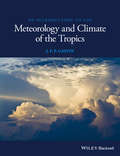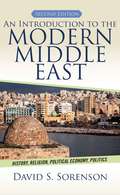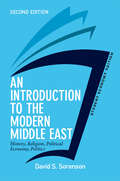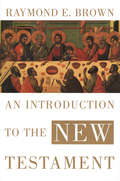- Table View
- List View
An Introduction to the International Criminal Court
by William A. SchabasThe International Criminal Court has ushered in a new era in the protection of human rights. Protecting against genocide, crimes against humanity and war crimes, the Court acts when national justice systems are unwilling or unable to do so. Written by the leading expert in the field, the fourth edition of this seminal text considers the Court in action: its initial rulings, cases it has prosecuted and cases where it has decided not to proceed, such as Iraq. It also examines the results of the Review Conference, by which the crime of aggression was added to the jurisdiction of the Court and addresses the political context, such as the warming of the United States to the Court and the increasing recognition of the inevitability of the institution.
An Introduction to the International Criminal Court
by William A. SchabasThis is the authoritative introduction to the International Criminal Court, fully updated in this sixth edition. The book covers the legal framework of the Court, the cases that it has heard and that are still to come, and the political debates surrounding its operation. It is written by one of the major authorities on the subject, in language accessible to non-specialists. The sixth edition brings legal references fully up to date in light of the Court's case law. Several trials have now been completed, with four convictions and a number of controversial acquittals. The book also discusses the situations that the Court is currently investigating, including Palestine, Georgia, Ukraine, Venezuela and the UK in Iraq, as well as the decision by a Pre-Trial Chamber not to authorise an investigation into Afghanistan. It also looks into the crisis with African states and the hostility of the United States to the institution.
An Introduction to the Israeli-Palestinian Conflict
by Akan MaliciAs one of the most enduring and bitter struggles we have seen in over 100 years, the Israeli-Palestinian conflict is a powder keg, always on the verge of exploding and drawing in the wider region, the international community at large, and, in particular, the U.S. Although the conflict is of far-reaching importance, among college students and the general public there is a dearth of knowledge about it. Many of the conversations in these audiences are animated by ongoing myths and problematic talking points. This book fills in the gaps of understanding while puncturing false dichotomies and tearing down walls of ideology or indifference. It addresses perennial questions including: When and why did the conflict start? What exactly are the claims of the contending sides? Why does peace seem unattainable? What is a likely long-term outcome and how can it be brought about in a peaceful way, doing justice to both sides? Finally, this book maintains that historic Palestine, the land between the Mediterranean and the Jordan River, must become a home for both Palestinians and Jews, with equal standings for both and without exclusive claims for either. For students, scholars, and citizens of the world, this book provides a concise and level-headed way to understand one of the most complex and vexing conflicts of our time.
An Introduction to the Kolmogorov–Bernoulli Equivalence (SpringerBriefs in Mathematics)
by Gabriel Ponce Régis VarãoThis book offers an introduction to a classical problem in ergodic theory and smooth dynamics, namely, the Kolmogorov–Bernoulli (non)equivalence problem, and presents recent results in this field. Starting with a crash course on ergodic theory, it uses the class of ergodic automorphisms of the two tori as a toy model to explain the main ideas and technicalities arising in the aforementioned problem. The level of generality then increases step by step, extending the results to the class of uniformly hyperbolic diffeomorphisms, and concludes with a survey of more recent results in the area concerning, for example, the class of partially hyperbolic diffeomorphisms. It is hoped that with this type of presentation, nonspecialists and young researchers in dynamical systems may be encouraged to pursue problems in this area.
An Introduction to the Kähler-Ricci Flow (Lecture Notes in Mathematics #2086)
by Sebastien Boucksom Philippe Eyssidieux Vincent GuedjThis volume collects lecture notes from courses offered at several conferences and workshops, and provides the first exposition in book form of the basic theory of the Kähler-Ricci flow and its current state-of-the-art. While several excellent books on Kähler-Einstein geometry are available, there have been no such works on the Kähler-Ricci flow. The book will serve as a valuable resource for graduate students and researchers in complex differential geometry, complex algebraic geometry and Riemannian geometry, and will hopefully foster further developments in this fascinating area of research. The Ricci flow was first introduced by R. Hamilton in the early 1980s, and is central in G. Perelman's celebrated proof of the Poincaré conjecture. When specialized for Kähler manifolds, it becomes the Kähler-Ricci flow, and reduces to a scalar PDE (parabolic complex Monge-Ampère equation). As a spin-off of his breakthrough, G. Perelman proved the convergence of the Kähler-Ricci flow on Kähler-Einstein manifolds of positive scalar curvature (Fano manifolds). Shortly after, G. Tian and J. Song discovered a complex analogue of Perelman's ideas: the Kähler-Ricci flow is a metric embodiment of the Minimal Model Program of the underlying manifold, and flips and divisorial contractions assume the role of Perelman's surgeries.
An Introduction to the Language of Category Theory (Compact Textbooks in Mathematics)
by Steven RomanThis textbook provides an introduction to elementary category theory, with the aim of making what can be a confusing and sometimes overwhelming subject more accessible. In writing about this challenging subject, the author has brought to bear all of the experience he has gained in authoring over 30 books in university-level mathematics. The goal of this book is to present the five major ideas of category theory: categories, functors, natural transformations, universality, and adjoints in as friendly and relaxed a manner as possible while at the same time not sacrificing rigor. These topics are developed in a straightforward, step-by-step manner and are accompanied by numerous examples and exercises, most of which are drawn from abstract algebra. The first chapter of the book introduces the definitions of category and functor and discusses diagrams, duality, initial and terminal objects, special types of morphisms, and some special types of categories, particularly comma categories and hom-set categories. Chapter 2 is devoted to functors and natural transformations, concluding with Yoneda's lemma. Chapter 3 presents the concept of universality and Chapter 4 continues this discussion by exploring cones, limits, and the most common categorical constructions - products, equalizers, pullbacks and exponentials (along with their dual constructions). The chapter concludes with a theorem on the existence of limits. Finally, Chapter 5 covers adjoints and adjunctions. Graduate and advanced undergraduates students in mathematics, computer science, physics, or related fields who need to know or use category theory in their work will find An Introduction to Category Theory to be a concise and accessible resource. It will be particularly useful for those looking for a more elementary treatment of the topic before tackling more advanced texts.
An Introduction to the Language of Mathematics
by Frédéric MynardThis is a textbook for an undergraduate mathematics major transition course from technique-based mathematics (such as Algebra and Calculus) to proof-based mathematics. It motivates the introduction of the formal language of logic and set theory and develops the basics with examples, exercises with solutions and exercises without. It then moves to a discussion of proof structure and basic proof techniques, including proofs by induction with extensive examples. An in-depth treatment of relations, particularly equivalence and order relations completes the exposition of the basic language of mathematics. The last chapter treats infinite cardinalities. An appendix gives some complement on induction and order, and another provides full solutions of the in-text exercises. The primary audience is undergraduate mathematics major, but independent readers interested in mathematics can also use the book for self-study.
An Introduction to the Lightning Process: The First Steps to Getting Well
by Phil ParkerYou may have already heard about the extraordinary results achieved by people using the Phil Parker Lightning Process® to transform and enhance their lives, health and success.This book has been designed both as an essential first step for all those intending to take a Lightning Process® seminar and also as a resource for discovering more about this unique training programme.Thousands worldwide have achieved extraordinary results using the Phil Parker Lightning Process®. The Lightning Process® can bring about incredible results in many areas where nothing else has worked, including:• CHRONIC FATIGUE SYNDROME/ME• MULTIPLE SCLEROSIS• IBS/DIGESTIVE ISSUES• CHRONIC PAIN• ADDICTION• DEPRESSION• WEIGHT LOSS• LOW SELF-ESTEEM• ANXIETY/STRESS/PANIC ATTACKS• EATING DISORDERSTransform your health and wellbeing by learning the first steps of one of the most empowering mind-body trainings in the world.
An Introduction to the Making and Meaning of the Bible
by Michael B. ShepherdA comprehensive and orthodox guide to biblical origins and interpretation How did we get the Bible? How do we interpret it? And what does it mean for our lives today? Michael B. Shepherd introduces undergraduates and seminarians to these crucial questions in this reliable and thorough new textbook. Shepherd covers textual criticism, formation of the canon, and history of translation, all while remaining committed to Scripture&’s ultimate purpose—inviting us to salvation through Jesus Christ. Showing how the Bible directs its own interpretation, Shepherd encourages learners to listen to the Word of God, rather than twisting it to fit their own ends. His section-by-section treatment of the Bible encourages students to view the Bible as cohesive, while remaining sensitive to its diverse genres. Thorough and accessible, this textbook goes beyond typical historical introductions to spiritually form students learning to understand Scripture. An Introduction to the Making and Meaning of the Bible is the serious, evangelical introduction your students need and will reference for years to come.
An Introduction to the Making of Western Art: Materiality, Preservation and Change
by Susan L. GreenThis book is the first introduction to Western art that not only considers how choice of materials can impact form, but also how objects in different media can alter in appearance over time, and the role of conservators in the preservation of our cultural heritage.The first four chapters cover wall and easel paintings, sculpture, drawings, and prints, from the late Middle Ages to the present day. They examine, with numerous examples, how these works have been produced, how they might have been transformed, and how efforts regarding their preservation can sometimes be misleading or result in controversy. The final two chapters look at how photography, new techniques, and modern materials prompted innovative ways of creating art in the twentieth century, and how the rapid expansion of technology in the twenty-first century has led to a revolution in how artworks are constructed and seen, generating specific challenges for collectors, curators, and conservators alike.This book is primarily directed at undergraduates interested in art history, museum studies, and conservation, but will also be of interest to a more general non-specialist audience.
An Introduction to the Market System
by Kalman GoldbergThe overriding objective of this text is to help students understand the economic context in which they play out their personal and professional lives, both in the United States and in the world. It seeks to overcome the indifference of non-economics majors at the college level.
An Introduction to the Mathematical Theory of Dynamic Materials (Advances in Mechanics and Mathematics #15)
by Konstantin A. LurieThis fascinating book is a treatise on real space-age materials. It is a mathematical treatment of a novel concept in material science that characterizes the properties of dynamic materials--that is, material substances whose properties are variable in space and time. Unlike conventional composites that are often found in nature, dynamic materials are mostly the products of modern technology developed to maintain the most effective control over dynamic processes.
An Introduction to the Mathematical Theory of Finite Elements (Dover Books on Engineering)
by J. N. Reddy J. T. OdenThis introduction to the theory of Sobolev spaces and Hilbert space methods in partial differential equations is geared toward readers of modest mathematical backgrounds. It offers coherent, accessible demonstrations of the use of these techniques in developing the foundations of the theory of finite element approximations.J. T. Oden is Director of the Institute for Computational Engineering & Sciences (ICES) at the University of Texas at Austin, and J. N. Reddy is a Professor of Engineering at Texas A&M University. They developed this essentially self-contained text from their seminars and courses for students with diverse educational backgrounds. Their effective presentation begins with introductory accounts of the theory of distributions, Sobolev spaces, intermediate spaces and duality, the theory of elliptic equations, and variational boundary value problems. The second half of the text explores the theory of finite element interpolation, finite element methods for elliptic equations, and finite element methods for initial boundary value problems. Detailed proofs of the major theorems appear throughout the text, in addition to numerous examples.
An Introduction to the Mathematical Theory of Inverse Problems (Applied Mathematical Sciences #120)
by Andreas KirschThis book introduces the reader to the area of inverse problems. The study of inverse problems is of vital interest to many areas of science and technology such as geophysical exploration, system identification, nondestructive testing and ultrasonic tomography. The aim of this book is twofold: in the first part, the reader is exposed to the basic notions and difficulties encountered with ill-posed problems. Basic properties of regularization methods for linear ill-posed problems are studied by means of several simple analytical and numerical examples. The second part of the book presents two special nonlinear inverse problems in detail - the inverse spectral problem and the inverse scattering problem. The corresponding direct problems are studied with respect to existence, uniqueness and continuous dependence on parameters. Then some theoretical results as well as numerical procedures for the inverse problems are discussed. The choice of material and its presentation in the book are new, thus making it particularly suitable for graduate students. Basic knowledge of real analysis is assumed. In this new edition, the Factorization Method is included as one of the prominent members in this monograph. Since the Factorization Method is particularly simple for the problem of EIT and this field has attracted a lot of attention during the past decade a chapter on EIT has been added in this monograph as Chapter 5 while the chapter on inverse scattering theory is now Chapter 6.The main changes of this second edition compared to the first edition concern only Chapters 5 and 6 and the Appendix A. Chapter 5 introduces the reader to the inverse problem of electrical impedance tomography.
An Introduction to the Mathematical Theory of Inverse Problems (Applied Mathematical Sciences #120)
by Andreas KirschThis graduate-level textbook introduces the reader to the area of inverse problems, vital to many fields including geophysical exploration, system identification, nondestructive testing, and ultrasonic tomography. It aims to expose the basic notions and difficulties encountered with ill-posed problems, analyzing basic properties of regularization methods for ill-posed problems via several simple analytical and numerical examples. The book also presents three special nonlinear inverse problems in detail: the inverse spectral problem, the inverse problem of electrical impedance tomography (EIT), and the inverse scattering problem. The corresponding direct problems are studied with respect to existence, uniqueness, and continuous dependence on parameters. Ultimately, the text discusses theoretical results as well as numerical procedures for the inverse problems, including many exercises and illustrations to complement coursework in mathematics and engineering. This updated text includes a new chapter on the theory of nonlinear inverse problems in response to the field’s growing popularity, as well as a new section on the interior transmission eigenvalue problem which complements the Sturm-Liouville problem and which has received great attention since the previous edition was published.
An Introduction to the Mathematics of Planning and Scheduling
by Geza Paul BottlikThis book introduces readers to the many variables and constraints involved in planning and scheduling complex systems, such as airline flights and university courses. Students will become acquainted with the necessity for scheduling activities under conditions of limited resources in industrial and service environments, and become familiar with methods of problem solving. Written by an expert author with decades of teaching and industry experience, the book provides a comprehensive explanation of the mathematical foundations to solving complex requirements, helping students to understand underlying models, to navigate software applications more easily, and to apply sophisticated solutions to project management. This is emphasized by real-world examples, which follow the components of the manufacturing process from inventory to production to delivery. Undergraduate and graduate students of industrial engineering, systems engineering, and operations management will find this book useful in understanding optimization with respect to planning and scheduling.
An Introduction to the Mechanics of Incompressible Fluids
by Michel O. DevilleThis open access book allows the reader to grasp the main bulk of fluid flow problems at a brisk pace. Starting with the basic concepts of conservation laws developed using continuum mechanics, the incompressibility of a fluid is explained and modeled, leading to the famous Navier-Stokes equation that governs the dynamics of fluids. Some exact solutions for transient and steady-state cases in Cartesian and axisymmetric coordinates are proposed. A particular set of examples is associated with creeping or Stokes flows, where viscosity is the dominant physical phenomenon. Irrotational flows are treated by introducing complex variables. The use of the conformal mapping and the Joukowski transformation allows the treatment of the flow around an airfoil. The boundary layer theory corrects the earlier approach with the Prandtl equations, their solution for the case of a flat plate, and the von Karman integral equation. The instability of fluid flows is studied for parallel flows using the Orr-Sommerfeld equation. The stability of a circular Couette flow is also described. The book ends with the modeling of turbulence by the Reynolds-averaged Navier-Stokes equations and large-eddy simulations. Each chapter includes useful practice problems and their solutions. The book is useful for engineers, physicists, and scientists interested in the fascinating field of fluid mechanics.
An Introduction to the Medieval Bible
by Frans Van LiereThe Middle Ages spanned the period between two watersheds in the history of the biblical text: Jerome's Latin translation c. 405 and Gutenberg's first printed version in 1455. The Bible was arguably the most influential book during this time, affecting spiritual and intellectual life, popular devotion, theology, political structures, art, and architecture. In an account that is sensitive to the religiously diverse world of the Middle Ages, Frans van Liere offers here an accessible introduction to the study of the Bible in this period. Discussion of the material evidence - the Bible as book - complements an in-depth examination of concepts such as lay literacy and book culture. This introduction includes a thorough treatment of the principles of medieval hermeneutics, and a discussion of the formation of the Latin bible text and its canon. It will be a useful starting point for all those engaged in medieval and biblical studies.
An Introduction to the Meteorology and Climate of the Tropics
by J. F. GalvinWhat do we mean by the tropics? The weather and the climates it produces across the tropical zone are significantly different from those experienced by the people living in higher latitudes, so forecasters across Europe and much of North America are unfamiliar with its effects. In this book, Jim Galvin demystifies the topic in this zone that is increasingly of interest to those studying weather and climate. This book was written for weather forecasters, meteorology, environmental science and geography students as an introductory guide. It builds on the experience of the author, his professional experience in the World Area Forecast Centre at the Met Office, Exeter, using studies into the weather and climate seen within the tropical air mass conducted over many years. Its unique approach presents a practical approach to tropical weather studies, drawing on both academic and practical knowledge, covering air mass dynamics, seasonal changes, moist and dry weather, climate variability and human health in chapters and appendices that build up the overall picture, summarising our current state of knowledge. As an overview, it covers the broad range of effects connected with climate and weather in a straightforward way and is clearly illustrated throughout.
An Introduction to the Modern Middle East
by David S. SorensonCombining elements of comparative politics with a country-by-country analysis, author David S. Sorenson provides a complete and accessible introduction to the modern Middle East. With an emphasis on the politics of the region, the text also dedicates chapters specifically to the history, religions, and economies of countries in the Persian (Arabian) Gulf, the Eastern Mediterranean, and North Africa. In each country chapter, a brief political history is followed by discussions of democratization, religious politics, women's issues, civil society, economic development, privatization, and foreign relations. In this updated and revised second edition, An Introduction to the Modern Middle East includes new material on the Arab Spring, the changes in Turkish politics, the Iranian nuclear issues, and the latest efforts to resolve the Israeli-Palestinian dilemma. Introductory chapters provide an important thematic overview for each of the book's individual country chapters and short vignettes throughout the book offer readers a chance for personal reflection.
An Introduction to the Modern Middle East
by David S. SorensonCombining elements of comparative politics with a country-by-country analysis, author David S. Sorenson provides a complete and accessible introduction to the modern Middle East. With an emphasis on the politics of the region, the text also dedicates chapters specifically to the history, religions, and economies of countries in the Persian (Arabian) Gulf, the Eastern Mediterranean, and North Africa. In each country chapter, a brief political history is followed by discussions of democratization, religious politics, women's issues, civil society, economic development, privatization, and foreign relations. In this updated and revised second edition, An Introduction to the Modern Middle East includes new material on the Arab Spring, the changes in Turkish politics, the Iranian nuclear issues, and the latest efforts to resolve the Israeli-Palestinian dilemma. Introductory chapters provide an important thematic overview for each of the book's individual country chapters and short vignettes throughout the book offer readers a chance for personal reflection.
An Introduction to the Modern Middle East, Student Economy Edition: History, Religion, Political Economy, Politics
by David SorensonAn overview of the history, religion, political economy, and politics of the Middle East, with individual chapters devoted to each of the countries in the Persian (Arabian) Gulf, Eastern Mediterranean, and North Africa.
An Introduction to the Modern Middle East: History, Religion, Political Economy, Politics
by David S. SorensonCombining elements of comparative politics with a country-by-country analysis, author David S. Sorenson provides a complete and accessible introduction to the modern Middle East. With an emphasis on the politics of the region, the text also dedicates chapters specifically to the history, religions, and economies of countries in the Persian (Arabian) Gulf, the Eastern Mediterranean, and North Africa. In each country chapter, a brief political history is followed by discussions of democratization, religious politics, women's issues, civil society, economic development, privatization, and foreign relations.In this updated and revised second edition, An Introduction to the Modern Middle East includes new material on the Arab Spring, the changes in Turkish politics, the Iranian nuclear issues, and the latest efforts to resolve the Israeli-Palestinian dilemma. Introductory chapters provide an important thematic overview for each of the book's individual country chapters and short vignettes throughout the book offer readers a chance for personal reflection.
An Introduction to the New Testament
by Raymond E. BrownFrom the experience of a lifetime of scholarship, preaching, teaching, and writing, Raymond E. Brown covers the entire scope of the New Testament with ease and clarity. He walks readers book by book through the basic content and issues of the New Testament. While a wealth of information is contained in these pages, the work's most impressive features are the basic summaries of each book, a historical overview of the ancient Greco-Roman world, discussions of key theological issues, and the rich supplementary materials, such as illustrative tables, maps, bibliographies, and appendixes. Using this basic data, Brown answers questions raised by today's readers, relates the New Testament to our modern world, and responds to controversial issues, such as those raised by the Jesus Seminar. Every generation needs a comprehensive, reliable Introduction to the New Testament that opens the biblical text to the novice. Raymond E. Brown's An Introduction to the New Testament is the most trustworthy and authoritative guidebook for a generation seeking to understand the Christian Bible. Universally acknowledged as the dean of New Testament scholarship, Father Brown is a master of his discipline at the pinnacle of his career. Who else could cover the entire scope of the New Testament with such ease and clarity? This gifted communicator conveys the heartfelt concern of a beloved teacher for his students, as he walks the reader through the basic content and issues of the New Testament. Those opening to the New Testament for the first time and those seeking deeper insights could not ask for more in a primer to the Christian Bible.
An Introduction to the New Testament and the Origins of Christianity
by Delbert BurkettThis book offers an authoritative and accessible introduction to the New Testament and early Christian literature for all students of the Bible and anyone interested in the origins of Christianity. It is designed primarily for undergraduate courses in the New Testament, biblical studies and early Christianity. There are questions for in-class discussion and written assignment, step-by-step reading guides on individual works, special box features, charts, maps and numerous illustrations designed to facilitate student use. With this textbook and the Bible, the student should therefore have all the necessary basic texts.

